#spanish conquista
Text

(*Painting depicting Spaniard and Native American from Peru. From these unions were born mestizos, children of mixed Native and European ancestry.)
Due to an investigation my family is currently conducting to try to establish a Portuguese ancestor (for possible citizenship purposes), we have discovered that we likely descend from Beatriz de Torres y Moyachoque, the daughter of "Catalina" of Moyachoque (her real name having been erased during the Conquista), sister of the Muisca Cacique ("Chief," "Prince," or "Lord") of Tumerqué (in modern day Colombia), and the conquistador, Juan de Torre(s), who was commissioned to oversee the region of Tumerqué by the infamous Conquistador Gonzalo Jiménez de Quesada (the man obsessed with finding El Dorado.) Sadly, we don't have much information about Beatriz other than the fact that she married (or was married to) a former catholic priest, but there is a lot of information about her brother, Diego de Torres y Moyachoque, who became Cacique of Tumerqué upon the death (execution?) of their uncle, the former Cacique, and who went on to denounce the maltreatment of his people to the King of Spain on two occasions. Indeed, Diego de Torres y Moyachoque is considered the most important figure of 16th-century Colombia, and one of the first defenders of (what we would now call) human rights in Latin America.
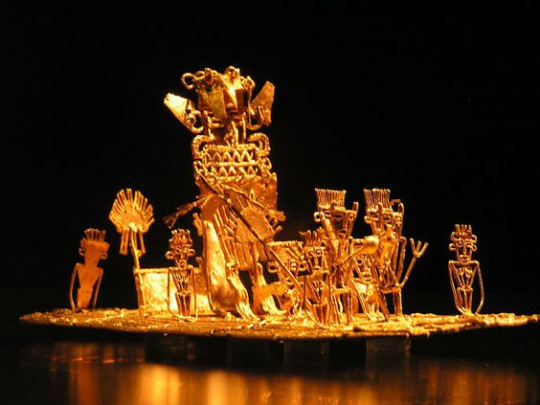
(*Muisca raft, depicting the possible origin of the El Dorado legend; El Dorado being a Cacique covered in gold dust during his coronation, and not a city.)
Juan de Torre(s), Diego and Beatriz's Spanish father, had two other children (also a boy and a girl) by a previous (or still standing) marriage in Spain. When Juan discovered that he was dying, he sent for his Spanish son, Pedro, to whom he gave the inheritance of his position in Tumerqué. This resulted in a very uncomfortable situation where the two half-brothers, Diego and Pedro, one a Mestizo Cacique, and one a Conquistador Overseer, were both concurrently presiding over the region. From what I've read, Pedro who, as it turns out, was a bit of a shit, had his brother declared illegitimate and stripped of his title of Cacique (which makes no sense, because ‘illegitimate’ by spanish standards or not, Muisca titles are passed on the female line, which makes Diego Cacique through his mother). In any case, it seems Diego recovered his title afterwards (because obviously???). There also seems to be some situation where, failing to find and punish Diego for sedition, the Spanish authorities took it out on Pedro, who lost “his” lands (and maybe his life?) as a result? I don’t know, the details seem hazy. In any case, the authorities did eventually catch up with Diego during a trip to Spain. There they accused him of undermining Spanish rule and imprisoned him. By the time they pardoned and released him, several years had gone by. At that point, he was so impoverished he could not afford to go home. Thus the last Cacique of Tumerqué, whose birthright it was to dress in the riches depicted in the image below, died in abject poverty.
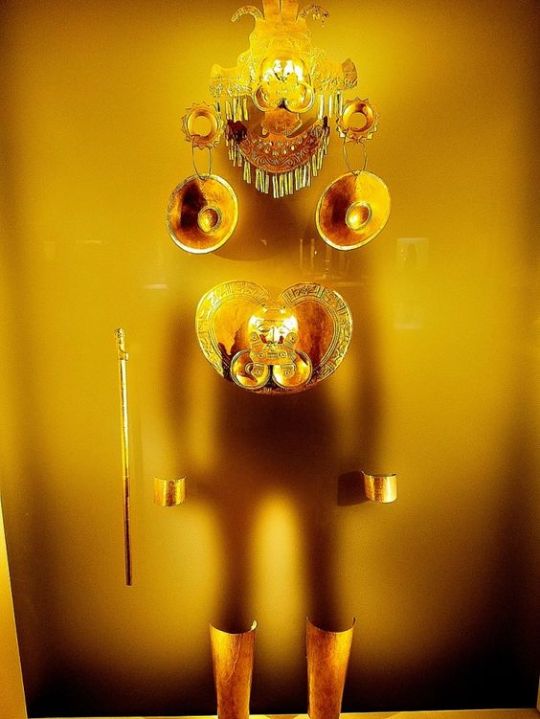
(*Ceremonial Muisca Gold on display in the Museo de Oro in Bogota, Colombia.)
How And Why I Am Able to Trace This Line: The reason I am able to trace my ancestry back this far, to Beatriz, is due to the fact that mestizo women like her, who were daughters of high-ranking conquistadors, were often married to men of similar rank within the Spanish Hierarchy. Given the lack of Spanish women around at the beginning of the Conquista, these women ended up forming a part of the 'elite' class, for which we have extensive documentation (land deeds, marriages, inheritances, postings, governorships etc.) High-ranking Mestizo men, like Beatriz's brother, Diego, would have had a harder time being integrated into the Spanish hierarchy, given that Spaniards would have been less likely to allow their daughters to enter into marriages with them (mestizo men were seen as "corrupting" the line and lowering the status of the women they married, as opposed to Spanish men.) That said, Diego did marry a Spanish woman when he was in Spain entreating the King, and had three children with her.
*It’s worth mentioning that Beatriz and Diego’s position was not the norm. Most mestizos, the children of other Spaniards and Native Americans, were not afforded any of the comforts, privileges or protections that these siblings were able to enjoy.

Note on Beatriz's Mother, "Catalina:" Since inheritance of titles and land in Muisca culture went through the female line (matrilineal), I suppose that the Conquistador Juan de Torre took Catalina, sister of the current Cacique, as his partner because it also placed him, a Spanish man, and their half Spanish children (Diego and Beatriz), in the direct line of succession by Muisca tradition. How better to secure the "legitimacy" of your rule and also diminish the traditional structures of a people than to make cultural "others" of their current and future leaders? The twist of fate was that unlike most high-ranking Mestizo sons, who tried to hide their native ancestry so as to better integrate with the Spanish, Diego embraced his Muisca birthright and took the title of Cacique. By this tradition, however, the title of Cacique would not have passed to Diego's children, but to Beatriz's (to her son but not to her son’s children; rather, to her daughter’s son; then to her daughter’s son’s nephew by a sister, etc.)

Oh and to add insult to injury, before the spanish decided to turn the Andes into the Alps (why???), the area around bogota was covered in purple flowering trees now known as Siete Cueros (”Seven Barks”) or Glory Tree. Can you imagine what that must have looked like? A purple valley? ((Source for this was a botanist at the Jardín Botánico in Bogota))
#personal#moyachoque#ancestry#native american#conquista#muisca#spanish conquista#Mestizo#mestizaje#spanish colonialism#spanish colonization#el dorado#colonialism#imperialism#latin america#chibcha#legend of el dorado
7 notes
·
View notes
Text
Second part of the bookscans of Al Andalus. Historical Figures, here's the previous part
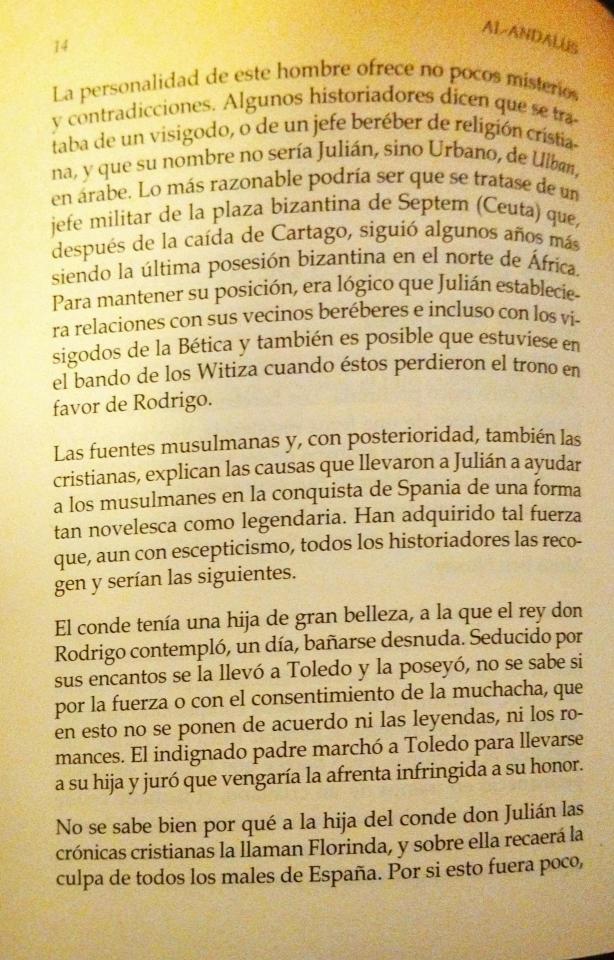
The personality of this man offers many mysteries and contradictions. Some historians say that he was a Visigoth, or a Berber of Christian religion, and that his name would not be Julián, but Urban, from Ulban, in Arabic. The most reasonable thing could be that he is a military commander from the Byzantine square of Septem (Ceuta) which, after the fall of Carthage, continued to be the last Byzantine position in North Africa for a few more years. To maintain his position, it was logical that Julián established relations with his Berber neighbors and even the Visigoths of Baetica and it is also possible that he was on the side of the Witizas when they lost the throne in favor of Rodrigo.
The Muslim sources and, later, also the
Christians, explain the causes that led Julián to help the Muslims in the conquest of Spania in such a way
novel as well as legendary. They have acquired such strength that, even
with skepticism, all historians collect them and they would be the following.
The count had a daughter of great beauty, whom the king Rodrigo, one day, contemplated her bathing naked. Seduced by her charms he took her to Toledo and possessed her, it is not known if because of force or with the consent of the girl, who in this neither legends nor romances agree. The indignant father marched to Toledo to take his daughter and swore
that he would avenge the affront inflicted on her honor.
It is not well known why the daughter of Count Don Julián is called Florinda in Christian chronicles, and on her will fall the
blame for all the ills of Spain. As if this were not enough,
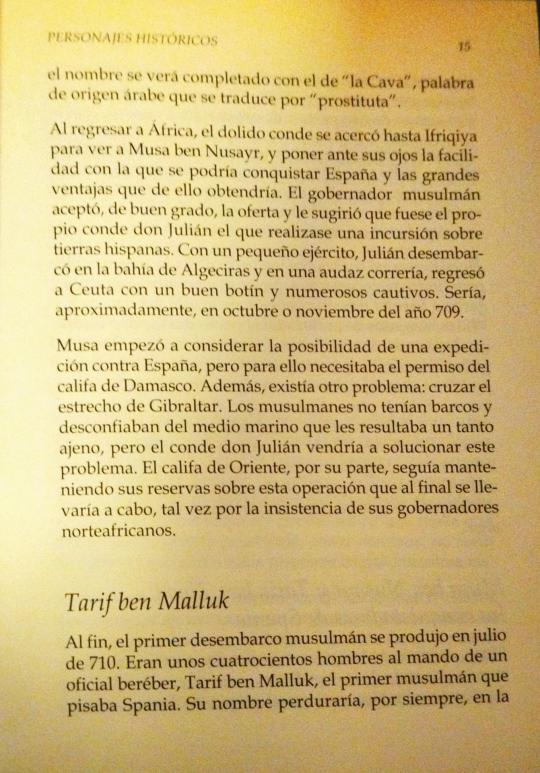
the name will be completed with “la Cava”, a word of Arabic origin which translates to "prostitute".
Upon returning to Africa, the hurt count went to Ifriqiya to see Musa ben Nusayr, and put before his eyes the ease with which one could conquer Spania and the great advantages that would be obtained from it. The Muslim governor willingly accepted the offer and suggested that it would be Count Don Julián himself who carried out an incursion onHispanic lands. With a small army, Julian landed in the bay of Algeciras and in a daring raid, he returned to Ceuta with good loot and numerous captives. It would be approximately October or November of the year 709.
Musa began to consider the possibility of an expedition against Spania, but for this he needed the permission of the Caliph of Damascus. In addition, there was another problem: crossing the Strait of Gibraltar. The Muslims did not have ships and distrusted the marine environment that they considered a bit strange, but Count Don Julián would come to solve this problem. The Caliph of the East, for his part, continued to maintain his reservations about this operation that would ultimately be carried out, perhaps because the insistence of their North African governors.
Tarif ben Malluk
Finally, the first Muslim landing occurred in July 710. There were about four hundred men under the command of a Berber officer, Tarif ben Malluk, the first Muslim to set foot in Spania. His name would last, forever, in the
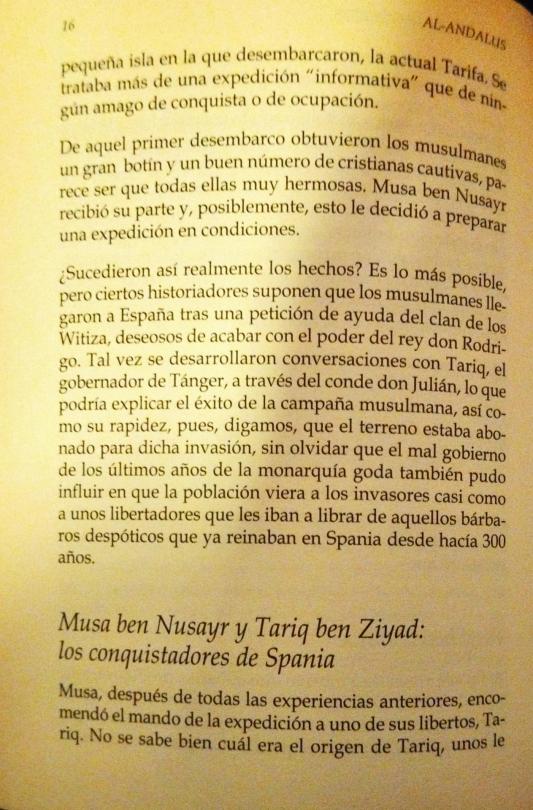
small island where they landed, the current Tarifa. It was more of an “informative” expedition than a threat of conquest or occupation.
From that first landing the Muslims obtained Muslims obtained a
great booty and a good number of captive Christian women, it seems to be
that all of them are very beautiful. Musa ben Nusayr received his part and, possibly, this decided him to prepare a proper expedition.
Did the events really happen like this? It is the most possible, butcertain historians suppose that the Muslims came to
Spania after a request for help from the Witiza clan, eager to put an end to the power of King Don Rodrigo. Maybe
conversations took place with Tariq, the governor of Tangier, through Count Don Julián, which could explain the
success of the Muslim campaign, as well as its speed, therefore, let's say that the ground was fertile for said invasion,
without forgetting that the bad government of the last years of the
Gothic monarchy could also influence the population to see the invaders almost as if they were liberators who were going to
rid of those despotic barbarians who already reigned in Spania for 300 years.
Musa ben Nusayr and Tariq ben Ziyad:
the conquerors of Spania
Musa, after all the previous experiences, entrusted the command of the expedition to one of his freedmen, Tariq.
It is not well known what Tariq's origin was, some
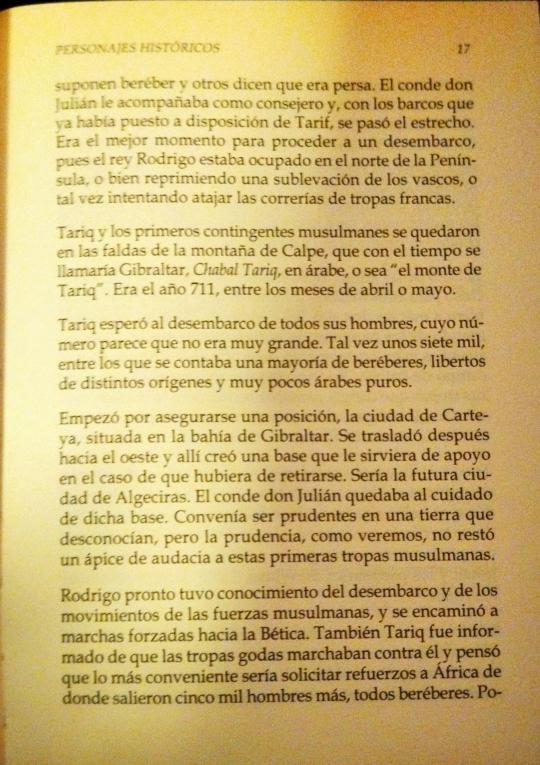
assume he was Berber and others say he was Persian. Count Don Julián
accompanied him as a counselor and, with the ships that he had already put to
Tarif's disposition, the strait was crossed. It was the best time to proceed to landing, since King Rodrigo was busy in the
north of the Peninsula, or repressing an uprising of the Basques, or perhaps trying to stop the raids of Frankish troops.
Tariq and the first Muslim contingents stayed in the foothills of the Calpe mountain, which in time would be called Gibraltar, Chabal Tariq, in Arabic, that is, “the mountain of Tariq.” It was the year 711,
between the months of April or May.
Tariq waited for all his men to disembark, whose number seems like it wasn't very big. Perhaps seven thousand, among whom the majority were Berbers, freedmen of different origins and
very few pure Arabs.
He began by securing a position, the city of Carteya, located in the bay of Gibraltar. He then moved west and there created
a base that would serve as support in the event that it had to backing out. It would be the future city of Algeciras. Count Don Julián was in the care of said base. It was advisable to be cautious in a
land that they did not know, but prudence, as we will see, did not took less audacity to these first Muslim troops.
Rodrigo soon learned of the landing and the movements of the Muslim forces, and set out on marches forced towards Baetica. Tariq was also informed that the
Gothic troops were marching against him and he thought that the most convenient
would be to request reinforcements from Africa where five thousand men came from
more, all Berbers. Po-
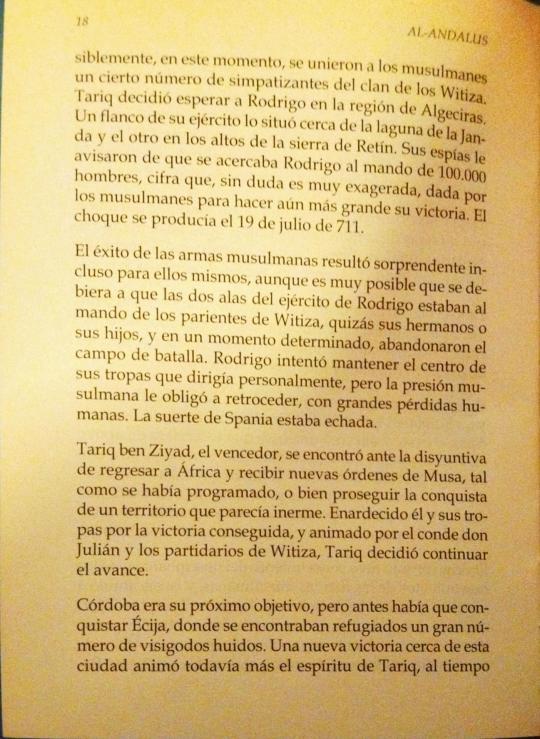
ssibly, at this time, the Muslims were joined by a certain number of sympathizers of the Witiza clan. Tariq decided
wait for Rodrigo in the region of Algeciras. One flank of his army was placed near the Janda lagoon and the other on the heights of the Retín mountain range. His spies warned him that Rodrigo was approaching
commanding 100,000 men, a figure that is undoubtedly very exaggerated, given by the Muslims to make even bigger their victory. The clash occurred on July 19, 711.
The success of Muslim weapons was surprising even for themselves, although it is very possible that it was because
the two wings of Rodrigo's army were commanded by the relatives of Witiza, perhaps his brothers or his children, and in a certain moment, they left the battlefield. Rodrigo tried to hold the center of his troops that he led personally, but Muslim pressure forced him to retreat,
with great human losses. Spania's luck was
cast.
Tariq ben Ziyad, the victor, found himself faced with the dilemma of returning to Africa and receiving new orders from Musa, as had been scheduled, or continuing the conquest of a territory that seemed defenseless. He and his troops were enraged by the victory achieved, and encouraged by Count Don Julián and Witiza's supporters, Tariq decided to continue the advance.
Córdoba was their next objective, but first they had to conquer Écija, where a large number of escaped Visigoths were taking refuge. A new victory near this city encouraged Tariq's spirit even more, while
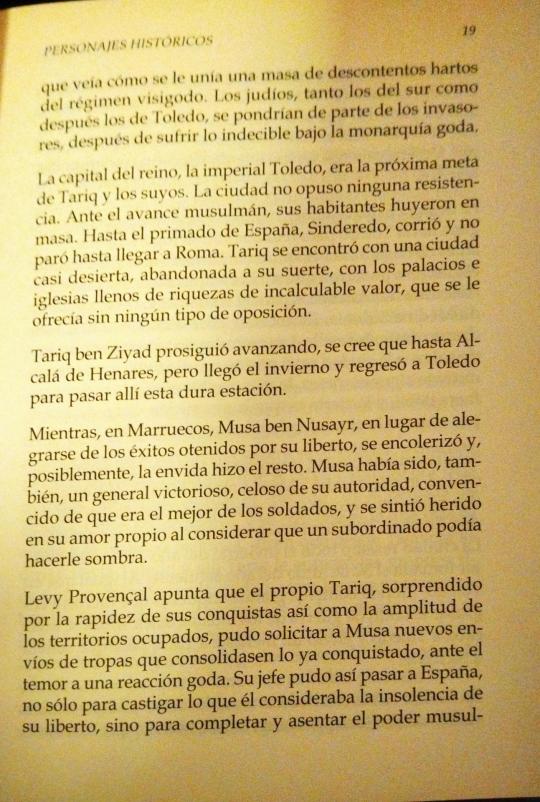
he saw how he was joined by a mass of dissatisfied people fed up with the Visigothic regime. The Jews, both those of the south and later those of Toledo, would side with the invaders, after suffering the unspeakable under the Gothic monarchy.
The capital of the kingdom, the imperial Toledo, was the next goal of Tariq and his people. The city did not put up any resistance. Faced with the Muslim advance, its inhabitants fled. Even the primate of Spania, Sinderedo, ran away and did not stop until he reached Rome. Tariq found an almost deserted city, abandoned to its fate, with palaces and churches full of riches of incalculable value, which were offered to him without any type of opposition.
Tariq ben Ziyad continued advancing, it is believed as far as Alcalá de Henares, but winter arrived and he returned to Toledo to spend this hard season there.
Meanwhile, in Morocco, Musa ben Nusayr, instead of rejoicing at the successes achieved by his freedman, became angry and, possibly, envy did the rest. Musa had also been a victorious general, jealous of his authority, convinced that he was the best of soldiers, and he felt hurt in his self-esteem when he considered that a subordinate could overshadow him.
Levy Provençal points out that Tariq himself, surprised by the speed of his conquests as well as the breadth of the occupied territories, was able to request new shipments of troops from Musa to consolidate what had already been conquered, fearing a Gothic reaction. His leader was thus able to go to Spania, not only to punish what he considered the insolence of his freedman, but to complete and establish Mus-
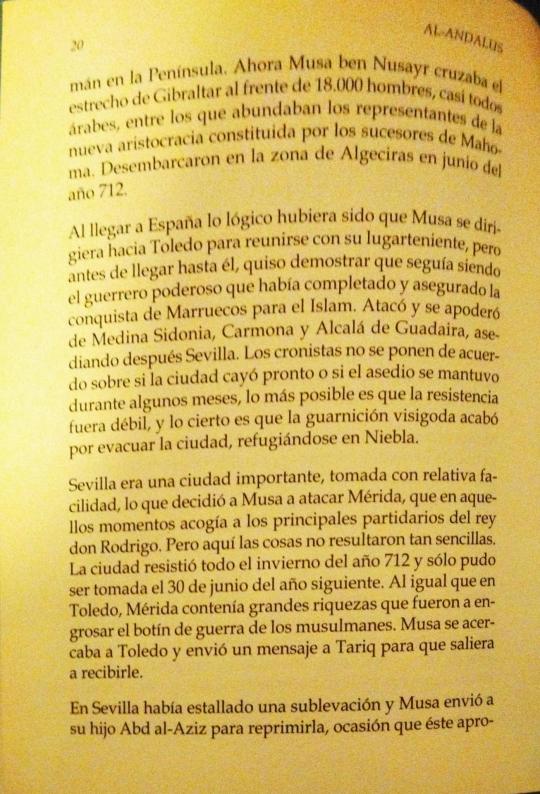
lim power on the Peninsula. Now Musa ben Nusayr crossed the Strait of Gibraltar at the head of 18,000 men, almost all Arabs, among whom were many representatives of the new aristocracy formed by the successors of Muhammad. They landed in the area of Algeciras in June of the year 712.
Upon arriving in Spania, it would have been logical for Musa to head towards Toledo to meet with his lieutenant, but before reaching him, he wanted to demonstrate that he was still the powerful warrior who had completed and ensured the conquest of Morocco for Islam. He attacked and took control of Medina Sidonia, Carmona and Alcalá de Guadaira, later besieging Seville. The chroniclers do not agree on whether the city fell soon or if the siege continued for a few months; it is most likely that the resistance was weak, and the truth is that the Visigoth garrison ended up evacuating the city, taking refuge in Niebla.
Seville was an important city, taken with relative ease, which decided Musa to attack Mérida, which at that time hosted the main supporters of King Don Rodrigo. But here things were not so simple. The city resisted throughout the winter of 712 and could only be taken on June 30 of the following year. As in Toledo, Mérida contained great riches that added to the war loot of the Muslims. Musa was approaching Toledo and sent a message to Tariq to come out to meet him.
An uprising had broken out in Seville and Musa sent his son Abd al-Aziz to suppress it, an opportunity that he took advantage
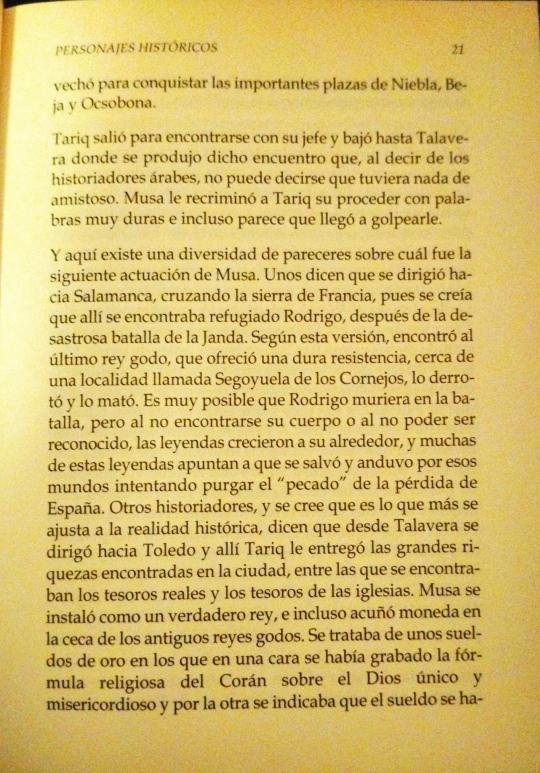
to conquer the important squares of Niebla, Beja and Ocsobona.
Tariq left to meet his boss and went down to Talavera where this meeting took place which, according to Arab historians, cannot be said to have had anything friendly. Musa reproached Tariq for his behavior with very harsh words and it seems that he even hit him.
And here there is a diversity of opinions about what Musa's next performance was. Some say that he headed towards Salamanca, crossing the Sierra de Francia, since it was believed that Rodrigo was taking refuge there after the disastrous battle of La Janda. According to this version, he found the last Gothic king, who offered tough resistance, near a town called Segoyuela de los Cornejos, defeated him and killed him. It is very possible that Rodrigo died in battle, but since his body was not found or could not be recognized, legends grew around him, and many of these legends suggest that he was saved and walked through those worlds trying to purge the “sin” of the loss of Spania. Other historians, and it is believed that this is what most closely corresponds to historical reality, say that from Talavera he headed towards Toledo and there Tariq gave him the great riches found in the city, among which were the treasures royals and the treasures of the churches. Musa installed himself as a true king, and even minted coins in the mint of the ancient Gothic kings. They were golden salaries on which the religious formula of the Koran about the only and merciful God had been engraved on one side and on the other it indicated that the salary had been
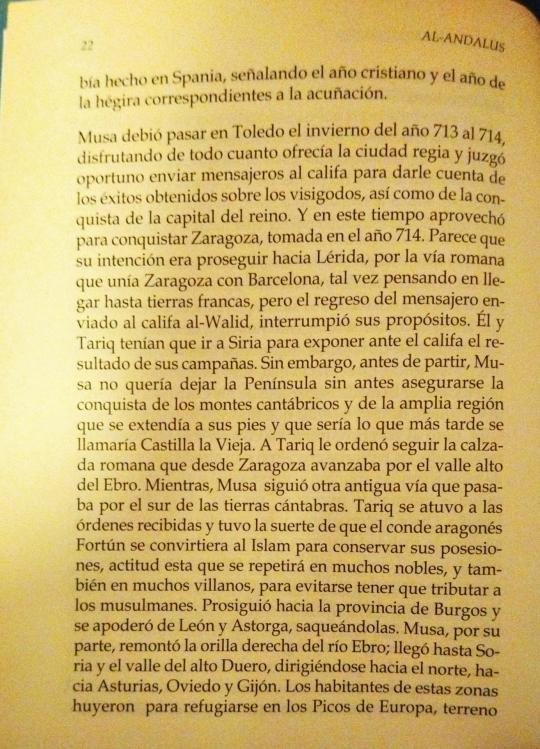
made in Spania, indicating the Christian year and the year of the hegira corresponding to the coinage.
Musa had to spend the winter from 713 to 714 in Toledo, enjoying everything that the royal city offered and considered it appropriate to send messengers to the caliph to inform him of the successes obtained against the Visigoths, as well as the conquest of the capital of the Kingdom. And at this time he took the opportunity to conquer Zaragoza, taken in the year 714. It seems that his intention was to continue towards Lleida, along the Roman road that linked Zaragoza with Barcelona, perhaps thinking of reaching Frankish lands, but when the messenger returned sent to the caliph al-Walid, interrupted his purposes. He and Tariq had to travel to Syria to present the results of their campaigns to the caliph. However, before leaving, Musa did not want to leave the Peninsula without first securing the conquest of the Cantabrian Mountains and the wide region that extended at its feet and which would later be called Old Castile. Tariq was ordered to follow the Roman road that advanced from Zaragoza through the upper Ebro valley. Meanwhile, Musa followed another ancient route that passed through the south of the Cantabrian lands. Tariq followed the orders he received and was lucky that the Aragonese count Fortún converted to Islam to preserve his possessions, an attitude that was repeated by many nobles, and also by many villains, so as not to have to pay taxes to Muslims. He continued towards the province of Burgos and took control of León and Astorga, plundering them. Musa, for his part, went up the right bank of the Ebro River; He reached Soria and the upper Duero valley, heading north towards Asturias, Oviedo and Gijón. The inhabitants of these areas fled to take refuge in the Picos de Europa mountain range, terrain
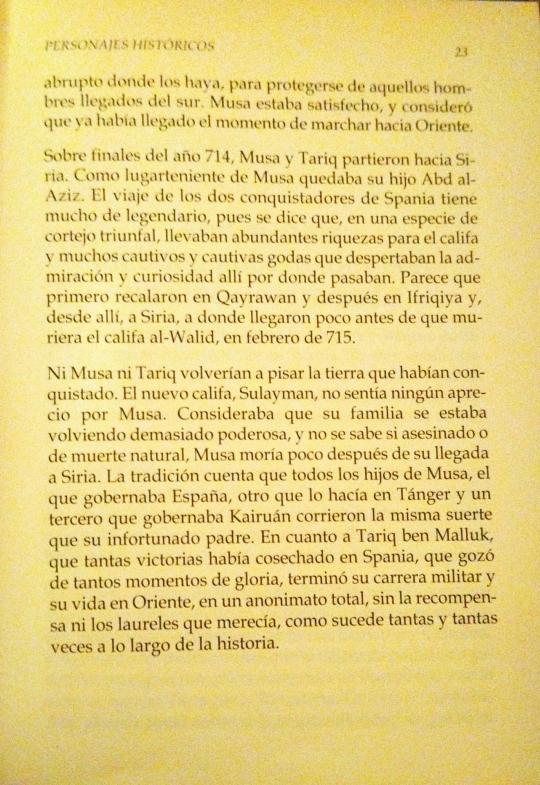
very abrupt, to protect themselves from those men arriving from the south. Musa was satisfied, and considered that the time had come to march towards the East.
Around the end of the year 714, Musa and Tariq left for Syria. Musa's lieutenant was his son Abd al-Aziz. The journey of the two conquerors of Spania is very legendary, since it is said that, in a kind of triumphal procession, they brought abundant riches for the caliph and many Gothic captives who aroused admiration and curiosity wherever they passed. It seems that they first landed in Qayrawan and then in Ifriqiya and, from there, to Syria, where they arrived shortly before the death of the Caliph al-Walid, in February 715.
Neither Musa nor Tariq would return to set foot on the land they had conquered. The new caliph, Sulayman, had no appreciation for Musa. He considered that his family was becoming too powerful, and it is not known whether murdered or a natural death, Musa died shortly after his arrival in Syria. Tradition says that all of Musa's sons, the one who ruled Spania, another who ruled in Tangier and a third who ruled Kairouan, suffered the same fate as their unfortunate father. As for Tarif ben Malluk, who had won so many victories in Spania, who enjoyed so many moments of glory, he ended his military career and his life in the East, in total anonymity, without the reward or laurels he deserved, as happens so many times throughout history.
#bookblr#historyblr#al andalus#al andalus. historical figures#al-andalus. personajes históricos#al andalus history#book scans#the conquest of al-andalus#fath al andalus#la conquista de al andalus#tariq ibn ziyad#musa ibn nusayr#tarif ibn malik#conde don julián#count don julián#julián de ceuta#spanish history
10 notes
·
View notes
Text

New world (Conquest of paradise)🌴💰🗡⚔️🛡💎 (mixed media on canvas)🥇
#new world order#new world#conquest#conquista#conquistador#spanish conquistadors#spanish history#madrid#Sevilla#mayan#aztec mythology#azteca#aztec#aztec gods#aztec culture#folk art#colonial history#colonial#colonial era#musket#battle#tenochtitlan#mexico city#reconquista#gold rush#oro#gold nugget#conquistadores#firearms#queen isabella
2 notes
·
View notes
Text
Prayer to Lord Ares

Written by me! Things may sound weird because it's translated from my language. Take a moment to appreciate how BEAUTIFUL he looks in this photo, I love him so much.
Warrior god,
drenched in blood and covered in wounds
he guides us in a desert field.
Father of Victory,
when the battle can only be won with violence.
My fists have is signature, I carry him with me.
In challenge, in pain, in misery.
Guide my legs to keep going when my strength fails me.
Lover of Aphrodite,
your calloused hands caress her hair like it's golden leaf.
When love and war collide is when the humans are born.
In victory, in pride, in joy.
Guide my legs to keep moving to the top.
May your strength inspire me, may the divine blood bathe me, may your arms push me to the conquest of battle.
Free me from fear, may the light of your sword illuminate my path.
Cure my wounds, scold me when necessary, because only your eyes, hungry with blood and victory, know where to take me and how far I've come.
Spanish version
Dios guerrero,
cubierto en sangre y heridas
nos guía en un campo desierto.
Padre de la Victoria,
cuando solo puede ganarse a gritos.
Cada golpe mío lleva su firma, en ello le llevo conmigo.
En el desafío, en el dolor, en la miseria.
Guía mis piernas a seguir adelante cuando fallan las fuerzas.
Amante de Afrodita,
manos callosas acarician su pelo como oro en paño.
Es cuando el amor y la guerra se unen
que el humano es creado.
En la victoria, en el orgullo y el gozo.
Guía mis piernas a seguir adelante hacia la cima.
Que su fuerza me inspire, su sangre me bañe,
que sus brazos me empujen a la conquista de la batalla.
Libreme de miedo, y su espada ilumine mi camino.
Cure mis heridas, griteme cuando sea necesario, porque solo sus ojos, inyectados en sangre y victoria, saben hasta dónde llevarme y hasta donde he llegado.
#helpol#hellenic worship#hellenic deities#hellenism#hellenic polytheism#greek gods#the gods#ares#lord ares#ares god of war#ares greek god
92 notes
·
View notes
Text
thanks to @the-avaricious-meddler's journal i can now explain just a few reasons WHY this es is so bad!!! brought to you by my not-even-that-extensive knowledge of maya history (my dad is central american, i majored in spanish, and i spent a semester in mexico)--
(1) the jaguar is not a villain just because it's a carnivore! it's a symbol of power and beauty made even more poignant for indigenous people in the wake of the conquista!
(2) the lords of xibalba weren't seen as these great guys! in fact, the popol vuh, the mayan creation myth, features the heroes defeating the lords of death (xibalba) in a ball game!
(3) yes, there were ritual killings in the pre-conquista americas, but they were way rarer than colonial history would have you think. also like literally every culture has ritual killings, it doesn't make a culture inherently violent
(4) holy shit the idea of a deferential indigenous leader who turns out to want your blood is so pervasive in racist conquistador accounts (if you haven't read hernan cortes's journals, don't, they are disgusting) holy shit
tl;dr the es puts its own assumptions onto maya culture! like thinking jaguar=scary=bad, or existence of underworld gods=people worship those gods=people worship death=people are bloodthirsty, or colonial-era accounts of indigenous people=how it actually was back then. at best that's ethnocentric, at worst, it's white supremacist!!
(anyway i'm a sensitivity reader on the side so failbetter hmu if you want to do BETTER and not FAIL (ba doom shh) )
148 notes
·
View notes
Note
Isn't Argentina as much of a settler state as the USA, Canada and Israel? Say, what happened to the Indigenous and the Afro population after independence?
The independent Argentine state commited genocide against the native peoples of Patagonia during the "Conquista del Desierto", and the less known yet not-less brutal colonization of the Great Chaco, by displacing or outright killing native populations. With regards to the Afrodescedant population, there was not an organized campaign of genocide, but rather a process of "invisibilization" where Afrodescendants hid their heritage to assimilate to eurocentric society, same with mestizo people. These are historical and current debts that the successive Argentine state has not repaid or adressed properly despite recent advances.
Sarmiento was the first and main architect of the conception of Argentina as a country for European inmigrants that "to modernize" needed to get rid of the native and afro-descendant population, the now celebrated figure of the gaucho, the same people who fought for independence, was disgusting to him. Julio A. Roca was inspired by the genocide of the native peoples of the United States and tried to use the same mentality and tactics here. Despite there have never been formal laws of racial separation, this mindset continued as part of state policy until roughly the early-20th century and still shapes national attitudes today.
Despite the desires of these men to destroy them, they ultimately failed. Over a milion (probably undercounted) Argentines belong multiple native peoples, with 30-40% of Argentines (depending on region) from partial or full native descent and 4-7% from african descent. Culturally, because of the aftermentioned process of invisibilization and the way the concept of race expresses itself in Latin America, there are fewer people who identify themselves with such groups than genetics show: racism still exists against "morochos", that is, brown-skinned people, compared to the Eurocentric ideal.
These are not hidden facts, they are taught in Argentine schools and universities, widely discussed and regarded as shameful, and they still shape our society and politics.
When I read the term "settler state" it confuses me because every Latin American country is a settler state, because by definition they were colonized by Spain and Portugal. Independent nations in Latin American inherited the racial and colonial mindsets of their "parent" empire. From Chile and Brazil, which also commited similar genocides on native lands following the procesess of the Spanish and Portuguese, to the opression of native and afro-descendants in favor of the european-descended elite in places like Perú, Bolivia and México, and the overall "blanqueamiento" (whitening, or however you want to call it) theory common to all Latin America where mestizaje was encouraged to "whiten" the popluation. Every Latin American nation was born, like it or not, from these violent processes.
The genocide did not begin with Argentine independence, it began in 1492, and it continues to this day. Similiarily, it has not started or stopped with a single administration or another, and it expresses itself in multiple ways. The only way to solve such deep rooted problems is by the state assuming its political, social and economical debt, but also for the entire mindset of society to change, which will take generations. I like to think we are progressing on that front, but when I see recent events such as the repression in Jujuy, I also know we have decades, if not centuries as my grandfather says, to go.
#I am of course assuming you asked this in good faith willing to learn and not as a 'gotcha Argentines are a bunch of nazis'#argentina
159 notes
·
View notes
Text

chapter fourteen — epilogo
➝ when the nature of their relationship is revealed to the world, fernando and charlie end up having a serious conversation about the direction they want to take.
➝ word count: 2,2k
➝ warnings: spanish media, insecurity
➝ author's note: tagging @christianpulisic10, @alonsogirlie, @he-is-the-destined, @sunnytkm23 and @enaticosencantados as requested.
Sitting on the couch with the remote in her hand, Charlie frantically scanned the channels on the television. Probably none of them would be broadcasting Brighton's game in Spain, after all, if the team wasn't facing one of the big clubs in England, nobody really cared. But, it wouldn't hurt to take a look to confirm.
However, she stopped on one of the channels when she saw a familiar image on the screen that made up the program's scenario.
— Las redes están alborotadas con esta imagen que finalmente lo confirma — the presenter announced in a happy voice — Fernando Alonso está de vuelta en las pistas y muy enamorado. El piloto asturiano, que sufrió una fractura de tobillo en el último Gran Premio de Las Vegas, fue visto en el circuito que lleva su nombre intercambiando abrazos y caricias con una mujer. Hablemos con Marina Rubel, que está en Oviedo, con más información. Marina?
The screen split to a live entry of a dark-haired woman who appeared to be in a park. Dropping the controller on the couch, Charlie couldn't stop watching, even though she didn't understand anything that was being said. But in a way, she didn't even need to.
— Hola Anne, buenas tardes. Esta es la confirmación de que el dos veces campeón de Fórmula 1 está, de hecho, en una nueva relación casi un año después de su ruptura con la periodista austriaca Andrea Schlager — the reporter said — Además del video que circula en las redes sociales, el propio Fernando publicó en su cuenta de Instagram una imagen de su nueva novia luciendo un mono y un casco de su escuela de karting, con el pie de foto "de vuelta a la pista".
— Hasta el momento, no se sabe quién sería esta misteriosa mujer, ¿verdad?
— Bueno, no se sabía. Sin embargo, nuestro equipo hizo un gran trabajo de investigación y tenemos, en exclusiva, el nombre de la nueva novia de Fernando Alonso. Descúbrelo en el informe.
A familiar photo appeared over the screen. Charlie's stomach twisted.
— La nueva novia de Fernando Alonso es un soplo de aire fresco en su lista de conquistas amorosas. Tras su matrimonio con la cantante Raquel del Rosario y largas relaciones con la presentadora Lara Álvarez y la modelo Linda Morselli, la nueva chica del "Nano" es su ingeniera de carrera, la inglesa Charlotte Whitlam — the reporter's voice said, as videos and photos of the podium in Suzuka were played — Puede que no la reconozcas por su imagen, pero Charlie, como la llaman, es la voz que escuchamos en las interacciones por radio entre Fernando y su equipo…
Suddenly, the television turned off.
Charlie let out a gasp of protest, before turning around to see Fernando's serious gaze. She felt like a naughty child who had just been caught doing something she shouldn't.
— Why were you watching this? — he asked.
— I wasn't — Charlie stammered, feeling his face heat up — I was looking for the Brighton match…
— That didn't look like the Brighton match, Charlie — Fernando said.
— I know…
He walked around the couch, crutches clicking on the floor as he stopped beside her and sat down. Looking down at her hands, Charlie couldn't shake the discomfort she'd been feeling, not just at being caught watching a news report about what had happened over the past 24 hours, but at being exposed like that.
The day before, after visiting the museum, Fernando took her to the circuit, where the go-kart shed used by students from the school he had set up there was located. After meeting the crew that maintained the equipment, showing her how he tightened the wheels as a teenager, and hearing more about how they took care of the engines, Fernando asked her if she wanted to go for a ride on the track.
— Can I? — Charlie asked, almost as if she were a child delighted by the possibility of playing with a new toy.
— Of course.
Changing into a set of the school's blue overalls and a helmet, Charlie could see through the opening in the visor the smile that Fernando had on his face. Asking her to wait a bit before sitting in the kart, he took his phone out of his pocket and took some pictures of her, telling her that she looked like a real Formula 1 driver.
After the last instructions, Charlie put her foot down on the accelerator, leaving the garage in the direction of the track. Allowing herself to experiment on the asphalt, she couldn't help but laugh when she caught too much of one of the kerbs in one of the corners or when she almost lost the rear at the last chicane. Driving the kart around made her feel strangely nostalgic, especially when she thought back to the times she and her grandfather had gone to a track in Northampton for a few laps.
When she pulled up in front of the garage, Charlie found Fernando with a wide smile on his face, leaning against the wall.
— So, what do you think? — he asked.
Charlie walked over to him as she took off her helmet and balaclava.
— It's amazing, the kart is very well adjusted and the track is excellent! — she exclaimed, smiling, while the driver took one of his hands to her forehead, fixing her disheveled bangs — And you, what did you think?
— You still need some lessons — Fernando replied, receiving a playful pat on the chest from Charlie — But you've got potential, nena, lots of potential.
After laughing, she gave him a soft kiss, one hand on his face, caressing the driver's cheek. A moment Charlie wanted to keep forever inside her heart and not have it recorded and posted to the entire world. The sensationalist headlines were already sketching in her mind, one worse than the other.
“Fernando Alonso takes his own engineer to bed”.
"Meet Charlie Whitlam, Alonso's newest girl".
"Charlie Whitlam: how an ordinary engineer got one of Formula 1's most eligible bachelors".
— Look, Charlie — Fernando said, breaking the silence in the living room — I already knew this was going to happen.
She glanced in the driver's direction with a raised eyebrow.
— Did you?
— Well, when you achieve a certain notoriety in Spain, let's say your life becomes the object of scrutiny by the press, such as…
— Tabloids? — Charlie asked. She was familiar with abuse in the British press, especially by the tabloids. It was not uncommon to see journalists crowding around the drivers in Silverstone, in search of an image or a bombastic statement to put on the covers of their newspapers.
— Yeah — Fernando replied — The point is that, in one way or another, they would connect the dots between us. And then they would come after us, wanting more and more, just…
— Like it was with all the other girlfriends you had — she completed.
— Yes. I never felt really bad for them because they were people who were used to it. They lived off their own image, so showing up with me wouldn't hurt them. In fact, they even took advantage of this to boost their own careers, which seemed stupid to me…
— You know you can't judge them, right?
— Why not?
— Because you also live off your image and appearing alongside them wouldn't hurt you either. By the way, didn't you pose for a magazine cover with one of them?
Fernando gave an embarrassed giggle.
— Yeah, I did. But… How do you know that?
— I watched your documentary — Charlie murmured.
— Did you? When?
— On the flight to Vegas. By the way, I thought that magazine cover was shit.
He looked shocked.
— But the cover…
— It has a clear power imbalance between you and her, with the clothes and all. I would even say that it was sexist.
— I was shirtless.
— Wearing a suit coat and with her body covering your chest. It was ridiculous, Fer.
The driver stared at her for a few seconds before smiling, squeezing Charlie's hand.
— Okay, I admit, the idea was ridiculous.
— Sexist — she corrected.
— Ridiculous, sexist, any other descriptions you'd like to add?
— Disgusting. Idiotic. An offense to good taste.
— Okay, Charlie, I get it — Fernando sighed— The point is, you're different from them. You're not exactly a known person...
— People know my voice, they've seen me on television with you...
— Charlie, it's not the same as being my girlfriend. For these guys, you stop being a mere engineer to be a source of income. You stop being a person to be a character in their stories. And — he stopped, looking frustrated — Fuck, I didn't want that for you.
— No?
— You don't deserve to live in this scrutiny, in this monitored life, without any privacy, just because I love you — Fernando continued — I want my love to be something safe for you, to be something good and not a source of stress and fear.
Charlie looked at his hand thoughtfully.
— Where are you going with this story? — she asked quietly.
— I want you to know that you don't have to live through this if you don't want to.
— Are you giving me carte blanche to break up with you?
The driver's eyes widened.
— No, no, I don't want you to break up with me, Charlie. In fact, I want you by my side forever. But I don't want my life and everything that comes with it to become a burden on you.
— You would never be a burden, Fer.
— Maybe I'm not, but the spotlight is. Maybe the attention, the comments on the internet, the things people will say in the paddock, all of that is a burden. And I couldn't bear to see you fade just because I love you — he murmured — I want you to keep shining, Charlie. And I want to wake up every day with your light illuminating and warming me.
Something in his words made Charlie feel her eyes fill with tears. She had avoided love at all costs over the years. It was something too difficult, too terrifying for her. It wasn't worth investing in something that would only make her suffer and cry, clutching a bottle of wine and watching some sappy romance movie.
Then Fernando appeared in her life again. It was as if fate wanted them to settle the disputes that one had with the other. And the moment Charlie gave the driver a second chance, she allowed herself to discover a fantastic man, dedicated and loving, who cared about her and would do anything to see her happy.
Love was still difficult and terrifying for Charlie.
But, loving Fernando was the best thing that had happened in her life.
— I'll never fade as long as you're by my side — she said, with a small smile — I love you. And it won't be one article talking about me that will make me give up on you.
— Not even two?
— Not even a million — Charlie said, before approaching his face, giving a peck on his lips — Nothing in this world will make me give up on you.
Staring at her for a few seconds, Fernando smiled.
— You mean I can tell the whole world how much I love you?
— Well, it's not like nobody knows.
— But it wasn't me who said it, it was a bunch of nosy journalists. But, I think it’s time for me to say something and break the news on my own terms — he replied, taking his cell phone out of his pocket. Charlie almost immediately concluded what his plan was.
— Are you going to post a picture of us?
— Two, actually — the driver said, as he selected the images — If they want to know, they'll know.
— But — Charlie hesitated, looking at one of the photos — Do you need to post this one?
Fernando looked at her, one eyebrow raised.
— Don't you like this picture?
— I look terrible in it, Fer — she replied — Look at my hair, it's all messed up, I'm not wearing any makeup, and…
He chuckled, placing a hand on her face, his thumb lightly brushing her skin.
— You can be either way, I'll always find you beautiful — Fernando murmured — The most beautiful woman I've ever seen.
After searching a little more in the phone's gallery and finding a photo that showed the moment they were introduced to each other for the first time — with a Ron Dennis watching the moment attentively — the driver thought for long minutes before typing something in the telephone.
— “Two people never meet by chance” — Fernando said, looking at Charlie — What do you think?
— Are you talking about fate?
— Well, let's just say you made me believe in it.
She laughed.
— So it's my fault?
— Well, not only yours, but — the driver hesitated for a few seconds — There are only two ways to explain why we're together right now. One is careful planning and a crystal ball, which I believe is not the case. And the other is fate.
— So it was fate?
— Always has been, nena. You have always been my fate — Fernando said, before clicking the 'post' button.
#fa#fernando alonso#f1 fanfic#f1 fic#fernando alonso fanfic#fernando alonso fic#fernando alonso x oc#formula 1 fanfic#formula 1 fic#formula one fic#formula 1 x oc#formula one x oc#f1 x oc#formula one fanfic#nordswrites
45 notes
·
View notes
Text

SWELLBLOOM KIDS is a ttrpg built around Filipino beliefs and folklore. Here, you play as the eponymous swellbloom kids, whose moods rise and fall due to cosmic El Niño and La Niña, respectively. Sensitive to the movements of the universe, they are gifted supernatural abilities thanks to The Twelve Guardians, deities watching over the different parts of the year and forming a zodiac of sorts.
Swellbloom Kids features reimagined mythical figures, from the moon-eating snake Bakunawa (here, a primordial force of chaos seeking to swallow reality) to the personified cold La Niña (here, a rain goddess that warps time).
This ttrpg also contains plot hooks, so you can play within the various eras of Philippine history. Some examples are:
These Snake-Eyed Children- rebuild a local community during the age of epic heroes.
Love in the Time of Conquista - save the romance between the conquistador Juan de Salcedo and the princess Kandarapa during the founding of Spanish Manila.
Guardia de Honor - investigate a mysterious cult of bandits during the Philippine-American War.
When the Paddylarks Weep - unravel a family curse and the murders that come with it in 1950s Mindoro.
Swellbloom Kids is also a love letter to being neurodivergent - it's a game about being bipolar, written by a bipolar person. Hope you can check it out.
#swellbloom kids#ttprg#tabletop rpg#philippine history#philippine mythology#philippine folklore#philippine culture
32 notes
·
View notes
Text

The Feathered Serpent, digital art, 2024
My first ever Good Omens Big (mini?) Bang art! My wonderful writing partner @wayneverneseque-phd wrote a gorgeous fic, The Feathered Serpent, for the Good Omens Minisode Minibang. It takes place in Tenochtitlan (the capital city of the Mexica empire) in 1521, during the Spanish Conquista.
I fell in love with it from the description, and the fic itself was just as good--a nuanced, well-researched, and heartbreaking story. It was exciting to see Crowley and Aziraphale in Mesoamerica, and how they reconciled their ideologies with their chosen roles (Crowley as a priest of Queztalcoatl, Aziraphale as real-life Franciscan friar Geronimo de Aguilar).
What was even more exciting to me, though, was that it gave me a chance to explore my own indigenous Mexica heritage through fan art. I don't feel very connected to my roots, so it was remarkably healing to research and create this, especially the mural of Queztalcoatl.
I hope you read the story!
#good omens#gomm 2024#go minisode minibang#good omens minisode minbang#good omens fanart#good omens fanfiction#good omens historical#my art#sofscribbles#sof's scribbles
13 notes
·
View notes
Text
Lately I have realized the power of our ancestors in our history and present, the power of the origins and knowing where we come from.
Just to begin with, there are just a few of us who truly have the opportunity to know the past of our generations, and for me, today, when I hear the stories of my grandparents and great-uncles, I begin to appreciate the importance of my presence in this game (life).
I come from a family of Spaniards (like most Mexicans today, thanks to the well-known Conquest of America, but above all the arrival of Spanish immigrants to Mexico during the Spanish Civil War), and here, I have to do a short pause to highlight the books “La Cabeza de mi Padre” by Alma Delia Murillo and “El Viento conoce mi Nombre” by Isabel Allende. For me these two stories were the opening to this dimension of recognizing the power of the family, of stories, of the past, of human acts and of knowing that we are a set of everything that surrounds us, starting with the place where we were born (physical and also place, referring to the circle of people with whom you live your first years of life).
My grandparents and great-uncles María Concepción Catalina Roselló Alvarado (RIP), Enrique Gálvez Perez Valencia, Blanca Teresita del Niño Jesús Ramirez López, Fernando Álvarez Hiolito (RIP) and Josefina, they tell me (and had told me) stories about their childhood and they leave me perplexed when I notice that their memories are based on the people with whom they shared their lives, they know the exact places and perfect mileages between the town where they lived and the one their love ones did (7.5m from Posada de Llanes to La Malateria), they smile when they talk about their pranks, friends, brothers, parents, partners and children. And once again, this game goes by so quickly and the best part is who do you share the path with.
Thanks to those paths traveled by them, today, I am here. More than a story of my life, what I want to convey is only my thoughts, what today at my 26 years old I think about life and how through different experiences every day I am finding these pieces of the puzzle that are helping me be more aware of the beauty of the present.
Últimamente, me he dado cuenta del poder de nuestros antepasados en nuestra historia y presente, el poder de las raíces y del saber de dónde venimos.
Para empezar, somos pocos los que tenemos la oportunidad de conocer las historias de nuestros antecesores, y para mí, hoy, al escuchar a mis abuelos y tíos-abuelos empiezo a dimensionar el poder de mi presencia en este juego (vida).
Vengo de una familia de españoles (como la mayoría de los mexicanos hoy en día, gracias a la ya conocida Conquista de América, pero sobretodo la llegada de los inmigrantes españoles por la Guerra Civil a México), y es que aquí tengo que hacer una pequeña pausa para recalcar los libros de “La cabeza de mi Padre” de Alma Delia Murillo y “El viento conoce mi nombre” de Isabel Allende. Para mi, estas dos historias fueron la apertura a este dimensión de reconocer el poder de la familia, de las historias, del pasado, de los actos humanos y de saber que somos un conjunto de todo lo que nos rodea, empezando por el lugar donde nacimos (lugar fìsico y lugar refiriéndome al círculo de gente con el que vives tus primeros años de vida).
Mis abuelos y tíos-abuelos María Concepción Catalina Roselló Alvarado (QEPD), Enrique Gálvez Perez Valencia, Blanca Teresita del Niño Jesús Ramirez López, Fernando Álvarez Hiolito (QEPD) y Josefina, cuentan sus historias de infancia y me dejan perpleja al notar que sus recuerdos se basan en las personas con las que compartieron su vida, conocen los lugares exactos y kilometrajes perfectos que hay de distancia entre el pueblo en donde ellos vivìan y sus amores (7.5km de Posada de Llanes a La Malateria), sonríen cuando hablan de sus travesuras, de sus amigos, hermanos, padres, parejas e hijos. Y es que una vez más, este juego pasa tán rápido y la mejor parte es con quien lo compartes y recorres el camino.
Gracias a estos caminos recorridos por ellos, hoy, yo estoy aquí. Más que una historia de mi vida, lo que quiero transmitir es únicamente mis pensamientos, lo que hoy a mis 26 años pienso de la vida y cómo a través de distintas experiencias cada día voy encontrando estas piezas del rompecabezas que me van acercando a ser más consciente de la belleza del presente.


#reading#my writing#writeblr#people#history#family#love live#life lessons#wholesome#libraries#cosas de la vida#vida#familia#amor
2 notes
·
View notes
Text
love in the time of conquista.
Act I
The play opens in the royal palace of Tondo in 1571, a polity settled on the banks of the River Pasig’s delta. The crown princess, Kandarapa, vents to her widowed mother Salanta about how her uncle Lakan Dula has betrothed her to the unpleasant Rajah Tariq as part of a political alliance with the polity of Makabebe. Salanta asks her why, and Kandarapa cites that Rajah Tariq already has many wives due to being a Muslim. Urged by her mother to simply respect her uncle, Kandarapa storms out of the room, calling for her handmaidens as she will bathe in the River Pasig.
Meanwhile, the conquistador Juan de Salcedo and his aide Felipe Cepeda discuss the progress of Juan’s grandfather, Don Miguel Lopez de Legazpi, in establishing the city of Manila in the name of the Spanish crown. Juan explains that Manila was previously the polity of Maynila, ruled by Rajah Sulayman, before he swore fealty to Don Miguel. Felipe cautions him that Sulayman might still harbor some animosity towards Don Miguel, given the violent battles that took place just several months before.
Juan and Felipe come upon the Pasig to refill their waterskins when they hear some beautiful singing. Curious, they follow the sound until they come upon Kandarapa bathing in the river alongside her handmaidens. Upon seeing the two Spaniards, Kandarapa’s servants flee in fear; Felipe is also embarrassed to see a naked woman and excuses himself. Kandarapa, however, simply stands there as Juan stares, and a mutual attraction forms. Juan, coming to his senses, excuses himself.
Act II
A month after, Kandarapa is in her room, being dressed by her maidservant Amihan. She joyfully relates to Amihan how she has entered a romance with Juan, and how the two have been secretly meeting at night. Amihan is supportive, having served Kandarapa for a long time, but advises her to be cautious since she is still betrothed to Rajah Tariq. Kandarapa declares her love for Juan, and wishes to marry him.
Later on in the main room, Lakan Dula meets with Rajah Tariq, who is visiting and wants to see Kandarapa. Lakan Dula says she has just left, supposedly for an errand, and complains about how headstrong she is. Rajah Tariq brushes it off, and the two discuss Don Miguel’s invitation for a meeting. Rajah Tariq is quite hostile towards the Spaniards and actually wants to wage war, but Lakan Dula tempers him, saying Don Miguel is quite powerful and that they should wait and see.
Later on, Don Miguel and his lieutenant Martin de Goiti prepare for the meeting with Lakan Dula, Rajah Tariq, and the other rulers of the surrounding polities. They are wary of Rajah Tariq as well as Rajah Sulayman; Don Miguel assures Martin that they will confirm it during the meeting. He similarly expresses worry for Juan, hoping he marries a pure Spanish woman rather than a native one. Rajah Tariq, Lakan Dula, Rajah Sulayman, and his uncle Rajah Matanda arrive alongside numerous other rulers. As Don Miguel asks the rulers to confirm their fealty to him as he plans to expand Manila northward into their territories, Rajah Tariq rejects the proposal and declares war, jumping out the window.
Act III
The next day, war erupts between Rajah Tariq’s forces and those of Don Miguel. Lakan Dula meets with both Salanta and Kandarapa, puzzling over his next move: if Kandarapa marries Rajah Tariq, they would be making an enemy of the Spaniards. Kandarapa worries, but keeps her romance with Juan a secret. A messenger eventually arrives; he reports that the battle is over, Rajah Tariq has been killed by Martin and Juan via a cannonball to the chest, and Lakan Dula’s son and nephew, Lawin and Kalaw, have been captured as prisoners. Lakan Dula, though quiet, is clearly outraged, and leaves to meet with Don Miguel.
Later on, Kandarapa tends to Kalaw’s wounds, scolding him for his rash behavior. Don Miguel had released both him and Lawin as a gesture of goodwill. She reveals that she intends to marry Juan, to Kalaw’s indignation since Juan killed Rajah Tariq. Kandarapa declares that she never loved Rajah Tariq and pleads for Kalaw’s support, which he begrudgingly gives.
A similar scene is taking place in Don Miguel’s camp, with Juan and Martin recovering from the battle. Fray Alvarado, a priest part of Don Miguel’s expedition, passes by on the way to give some final rites to the dying. Juan stops him, and asks him for a favor, whispering in his ear. Martin looks on suspiciously.
That night in the forest, Juan and Kandarapa meet, having missed each other greatly. Kandarapa is saddened by how they are on opposite sides of a war, reluctant to get married. Juan says his grandfather will send him on an expedition up north soon where he might die, and says they should get married now. Fray Alvarado arrives, led there by Amihan, and officiates the wedding of Juan and Kandarapa, also baptizing the latter as a Christian. Kandarapa changes her name to Dolores de Salcedo as a sign of her love, and Amihan hurries with her back to the palace.
Act IV
At the Spanish camp, Juan happily informs Don Miguel about his marriage to Kandarapa, who outwardly shows joy. They are interrupted by Amihan, who delivers a package of lotus flowers on behalf of Lakan Dula’s family. Juan receives it and goes to his room, discovering a letter from Kandarapa hidden inside, declaring that she will wait for him. He reads it aloud as Don Miguel eavesdrops and becomes angered. However, Don Miguel pretends to cheerfully send Juan off on his expedition to Ilokos.
Several months pass, and Don Miguel sends Juan on consecutive campaigns to keep him away from his wife. While on a campaign, he composes a letter to Kandarapa and hands it off to a messenger to deliver back to Manila, wondering aloud why Kandarapa hasn’t replied even once.
Meanwhile in Tondo, Kandarapa frets over not having received any letters from Juan. She has already informed Lakan Dula about her marriage to Juan, and while disappointed he gives his support. Amihan arrives and worriedly relates a rumor she heard in town that Juan has married the princess of Kaog in Ilokos. Kandarapa is shaken; Kalaw then arrives and tells her he saw it in an official announcement that Juan was indeed married to the Kaog princess. Kandarapa despairs and retires to her room, where she expresses her sorrow at Juan having forgotten about her.
A few weeks later, Juan returns after another successful campaign, hurrying to the palace of Tondo to see Kandarapa. Kalaw angrily stops him at the gate, striking him and rebuking him for marrying another woman. Juan declares the rumors untrue, showing Kalaw the lotus flowers from Kandarapa he had kept in his breast pocket. Kalaw informs him that Kandarapa had died just yesterday of a broken heart. Juan is taken aback and leaves.
Back at the camp, Felipe, Martin, and Fray Alvarado comment on the ruckus that Juan is making. Fray Alvarado eventually figures out that Juan’s letters somehow weren’t reaching Kandarapa. The two look to Martin, who confesses that it was all Don Miguel’s doing and that he was in on it. Felipe then runs off to tell Juan.
Juan eventually confronts his grandfather about intercepting his letters. Don Miguel, by now the Governor-General of Manila, gets angry and states his wishes for Juan to have married a Spanish woman instead. Juan protests this, saying Don Miguel will never achieve progress until he views the natives as equals. Don Miguel sends him away.
In the last scene, set three years later, Juan is in a military campaign in Pangasinan. He mourns the loss of Kandarapa as well as Don Miguel, who died soon after she did. Fray Alvarado arrives and notices Juan has a fever, to which Juan then ambles outside in a state of delirium.
Out on the river, Juan muses that he had first met Kandarapa on the banks of a river. He declares his achievements, such as conquering numerous lands on the islands and defeating the Chinese pirate Lim Ah Hong, to be meaningless. He declares he will meet with Kandarapa again soon and drinks an excessive amount of cold river water before collapsing. Felipe comes upon him and tries to wake him up before discovering he is dead. He finds in Juan’s hands the dried lotus petals from Kandarapa. Felipe mourns his friend and decides aloud that he will write down his story so that his love will not be forgotten.
#philippine folklore#retelling#nick joaquin#juan de salcedo#kandarapa#miguel lopez de legazpi#wanted to go for a shakespearean tragedy vibe#obv not 100% historically accurate
2 notes
·
View notes
Note
As a Mexican, about the road to El dorado, and in Spanish, so you know I'm legit
Los libros de historia aquí dicen que los mexicas creyeron que los españoles eran dioses. Después de una breve investigación, parece que el mito fue creado y perpetuado por los mismos mexicas para guardar apariencias, por haber sufrido la conquista a pesar de haber sido tan formidable imperio.
Segundo, la cuidad no puede estar fuera del territorio maya, a pesar de que la arquitectura y otros elementos sugieran alternativas... Y el mural si da vibras mayas
La cosa de los dioses es que los registros que tenemos de la época son escritos por españoles, así que siempre me han dado mala espina.
Y la leyenda viene de los muiscas. Era un ritual que hacía un cacique antes de asumir el mando, se vestía con joyas y polvo de oro y se zambullía en la laguna de Guatavita mientras los demás miembros de la aldea botaban más joyas.
Esta es una balsa de oro que muestra el ritual, la puedes encontrar en el museo de oro de Bogotá:

Varias lagunas de la zona fueron drenadas por los españoles varias veces pero nunca encontraron gran cosa, así que asumieron que era otro sitio y de alguna manera la leyenda se convirtió en ciudad y la buscaron por todo el territorio conquistado. Incluso hay un artículo en wikipedia si quieres fuentes 🤷.
Mi punto es. Los que hicieron la película no se molestaron en hacer ni siquiera el mínimo de investigación. Después de todo, a nadie le importa una pequeña cultura aniquilada por los españoles en un país que sólo es famoso por violencia y drogas. Y lo peor de todo? Tenían razón. A nadie le importa.
8 notes
·
View notes
Text
Many of the elements that welcome the dead today—the music, the incense, the flowers, the food—were already in use among the indigenous people before the Spanish conquest in the sixteenth century. At the time of the conquista, a Dominican friar wrote that the native people were happy to adopt the Catholic festivals of All Saints and All Souls because they provided the perfect fronts for their existing festivals honoring the dead.
Attempts were made over the ensuing centuries to eradicate the practices, which were “above all, horrifying to the illustrious elite, who sought to expel death from social life.” In 1766, the Royal Office of Crime banned the indigenous population from gathering in their family cemeteries, cruelly cutting them off from their dead. But the customs, as they so often do, found a way to persist.
Over one home in Santa Fe de la Laguna, a sign in Purépecha read, “Welcome home, Father Cornelio.” Cornelio’s altar took up an entire room. I laid my bananas and oranges atop a growing pile, while the family’s matriarchs swooped in to offer us large, steaming bowls of pozole and mugs of atole, a hot drink of corn, cinnamon, and chocolate. For the families, this night is not just a one-way acceptance of offerings for their dead; it is an exchange with the community.
— From Here to Eternity: Traveling the World to Find the Good Death, Caitlin Doughty
#all saints#all souls day#all saints day#1766#royal office of crime#santa fe de la laguna#Purépecha#Caitlin Doughty#Ask a Mortician#From Here to Eternity: Traveling the World to Find the Good Death#From Here to Eternity#books#bookblr#death positive#death positive movement#nonfiction#science#history#travel#anthropology#memoir#sociology#atypicalreads#deathcare#cw death
5 notes
·
View notes
Text





Unas de mis fotografías de las alfombras que se realizan durante la Semana Santa de Antigua Guatemala, ciudad que es protagonista de mi libro La Historia Verdadera de los Hijos del Sol, el cual está dedicado al antigüeño Bernal Díaz del Castillo, quién escribiera el magnífico libro la Historia Verdadera de la Conquista de la Nueva España.
A continuación todos los enlaces directos de compra de mi libro La Historia Verdadera de los Hijos del Sol en España, EEUU y México.
🇪🇸𝐃𝐞𝐬𝐝𝐞 𝐄𝐬𝐩𝐚ñ𝐚:
Versión blanco y negro: https://amzn.eu/d/9vlhPq2
Versión en Color: https://amzn.eu/d/gulVEcA
🇺🇸𝐃𝐞𝐬𝐝𝐞 𝐄𝐄𝐔𝐔:
Versión blanco y negro: https://a.co/d/dofpXVp
Versión en Color: https://a.co/d/5BP2fVZ
🇲🇽𝐃𝐞𝐬𝐝𝐞 𝐌é𝐱𝐢𝐜𝐨:
Versión blanco y negro: https://a.co/d/j2aCWjr
Versión en color: https://www.amazon.com.mx/Historia-Verdadera-Libros-S%C3%A1nchez-Spanish/dp/B0BPG8547Y/ref=tmm_hrd_swatch_0?_encoding=UTF8&qid=1685547605&sr=8-1
𝐕𝐞𝐫𝐬𝐢ó𝐧 𝐏𝐃𝐅: https://chicosanchez.com/libros/ols/products/xn--la-historia-verdadera-de-los-hijos-del-sol-de-chico-snchez-bzexn---versin-digital-pdf-rcc
Gracias
3 notes
·
View notes
Text
La Reconquista De España
By: Jack Chasen
Un tiempo de el siglo de oro que muy importante es La Reconquista. Durante la centuria once, España quiere ser la región de Iberia. Iberia fue ocupado por los Muslims. España queiro él región por dos razones. Una razón es porque antes de la centuria once, los españoles tienen controlan de Iberia. Los Muslims fue capturado y ocupado el región por muchos años, y debilitado el ejército y el país de Españas.. Cuando los Españoles recuperan la fuerza, el ejército quiere recapturar Iberia. Otra razón es porque España tiene una creencia de cristiano. Los Muslims no fueron cristiano (obviamente) y los Españoles fue hacia el cruzado un meta primera de la conquista.
Por mucho tiempo, los Muslims controlaron mucho de España. La reconquista comenzó en 718, cuando el rey cristiano de España ganó la lucha de Covadonga. La victoria convince otras regiones de España que ataquen las regiones Muslim.
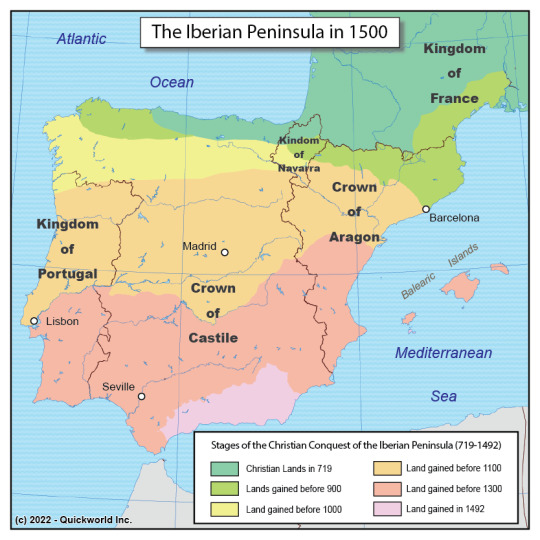
Muchos leders de el movimiento necessito converter los regiones muslim a cristiano. Muchos leders tiene tacticas muy daños y tristes para convertir y asesinato los Muslims. Pero, Alfonso IV, un leder de un region de España fue no convertir los Muslims y en cambio fue regla dos religiones. Alfonso refrencian a el que “un rey de dos religiones”.
youtube
Sin embargo, los Muslims no quieren abandaron la lucha. Los Muslims elisten el ayudado de los Almoravids, un grupo much brazo que consiste de Muslims de Norte Africa. Cuando los Almoravids llegaron a España, los Almoravids detener la lucha rapidamente, y assuman contrala de mucho de España. Los reinos cristianos fue attaque muchos reinos Almorávidos y eventualmente fracaso los Almorávides y completa la reconqustia.
Perro, en una historia muy complicado, los Almohados capturan la capital de los Almoravids y ganaron control. Consiauqamente, los Almohados recapturan los partes de España de los Muslims. Los cristianos en desesperación requestaron la ayudo de los otros reinos critainos. Los cristianos aceptan, y los ejercitos de Muslims fue muy daño y depletado.
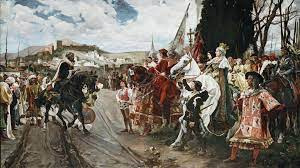
La reconquista experiencia un periodo muy pacifico después de 1236 porque los ejércitos necesitan reconstruir. En 1492, los reinos de España regana controlo y los ejércitos católicos fracasaron los muslims.
Los líderes de los reinos nuevas despues de la reconquista, Aragón y Castile, los reyes Ferdinand y Isabelle declara que las personas de los reinos necesitan convertir a cristiano o departan los reinos porque Ferdinand y Isabelle no quieran reglaron los Jews y Muslims, solamente los cristianos. Muchas personas que el leyo affectan fue convirtiran a cristiano, pero practicaron su religión en privado.
Un momento muy impacto de la historia ocuria despues de el evento. Isabelle y Ferdinand conocen que mucha gente practicaron su religión en privado, y Isabelle y Ferdinand fue creado el inquisición. Un evento muy devestada, los leders contribuyen a el murio y sufrir de muchos españoles.
En mi opinión, es necesario que las personas investiguen el contexto de los eventos de la historia. Muchas personas conocen de la reconquista y muchas personas conocen la inquisición, pero muchas personas no conocen que los eventos están relatados. El siglo de oro es un momento en la historia que tiene muchos eventos y impacto a el mundo. Yo esperanzo que tú aprende pequeña informacion.
Las citaciones:
3 notes
·
View notes